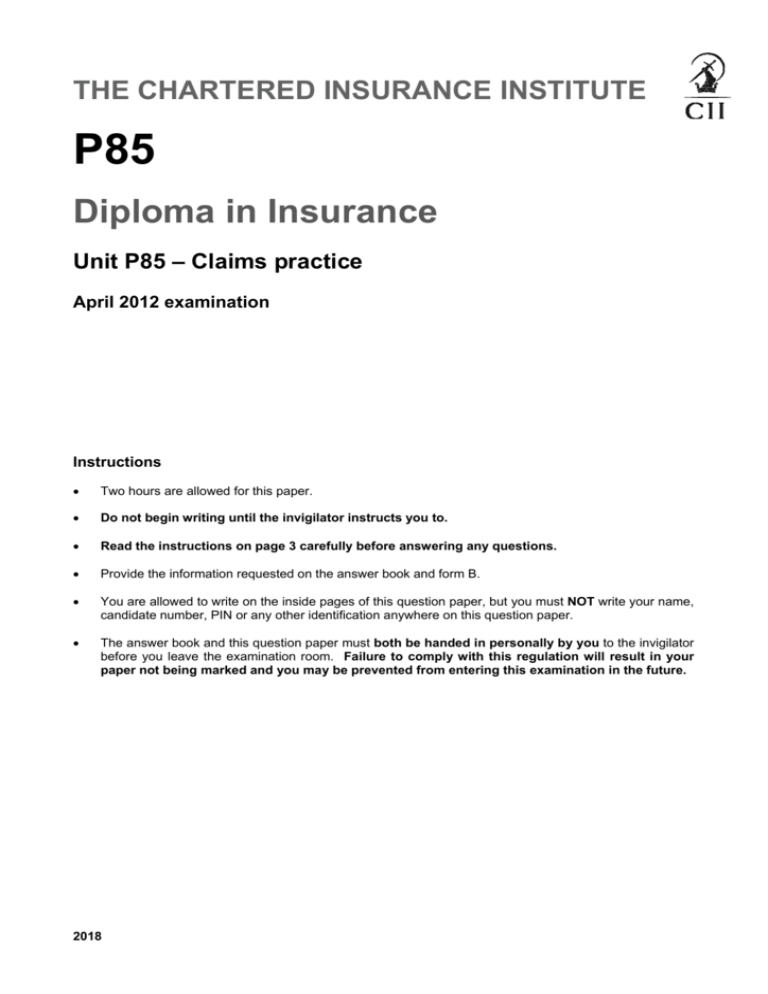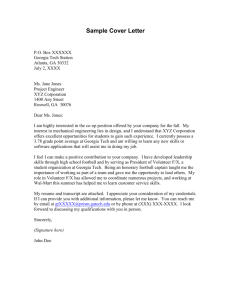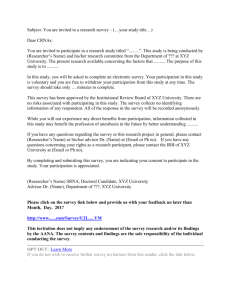
THE CHARTERED INSURANCE INSTITUTE
P85
Diploma in Insurance
Unit P85 – Claims practice
April 2012 examination
Instructions
Two hours are allowed for this paper.
Do not begin writing until the invigilator instructs you to.
Read the instructions on page 3 carefully before answering any questions.
Provide the information requested on the answer book and form B.
You are allowed to write on the inside pages of this question paper, but you must NOT write your name,
candidate number, PIN or any other identification anywhere on this question paper.
The answer book and this question paper must both be handed in personally by you to the invigilator
before you leave the examination room. Failure to comply with this regulation will result in your
paper not being marked and you may be prevented from entering this examination in the future.
2018
P85 April 2012
© The Chartered Insurance Institute 2012
2018
2
P85 April 2012
Unit P85 – Claims practice
Instructions to candidates
Read the instructions below before answering any questions
Two hours are allowed for this paper, which contains 15 short answer questions and carries a total of
130 marks.
Read carefully all questions and information provided before starting to answer. Your answer will be
marked strictly in accordance with the question set.
The number of marks allocated to each question part is given next to the question and you should
spend your time in accordance with that allocation.
You may find it helpful in some places to make rough notes in the answer booklet. If you do this, you
should cross through these notes before you hand in the booklet.
It is important to show each step in any calculation, even if you have used a calculator.
If you bring a calculator into the examination room, it must be a silent battery or solar-powered
non-programmable calculator. The use of electronic equipment capable of being programmed to hold
alphabetic or numerical data and/or formulae is prohibited. You may use a financial or scientific
calculator, provided it meets these requirements.
Answer each question on a new page. If a question has more than one part, leave six lines blank after
each part.
2018
3
PTO
P85 April 2012
Answer ALL questions
Note form is acceptable where this conveys all the necessary information
1.
Janet submits a claim to her insurance company for loss of her watch.
As the claims handler, state the three key stages through which this claim will now
progress.
2.
John’s personal insurance policy contains a clause which states that ‘it is a condition
precedent to liability under this policy that you must notify any claim to the insurer as soon
as practicable’.
Explain the purpose and effects of this clause.
3.
(12)
Jones plc is a large manufacturing company with a turnover in excess of millions of
pounds a year. Following a fire at their factory, their insurance claim is denied by their
insurer. The insurer rejects Jones plc’s formal complaint. Jones plc then decides to
challenge the denial.
Advise Jones plc on the route that their challenge may take.
4.
5.
Identify the three key pieces of Financial Services Authority (FSA) regulation which
applies to claims handling in the UK.
6.
John Smith has a personal insurance policy with XYZ Insurance. During the policy period
he submits two genuine claims which are paid by XYZ Insurance. The third claim is
discovered by XYZ Insurance to be partly fraudulent.
Explain, with reference to, case law the legal position relating to all three claims.
2018
(12)
Davis Brothers have public liability insurance with XYZ Insurance. Davis Brothers pass to
XYZ a letter from solicitors acting for a third party claimant who alleges injury as a result of
Davis Brothers’ negligence.
Identify the protocol under the Civil Procedure Rules which will be followed and the next
two steps that XYZ Insurance must take.
7.
(6)
Explain briefly why an insurer needs to supervise the claims handling carried out for them
by an outsourcer.
4
(6)
(6)
(12)
(6)
P85 April 2012
8.
Acme plc advises their insurance broker of a claim that has been made against them. The
broker does not pass on the details to Acme’s plc insurer until after Acme’s plc policy has
expired.
(a)
Identify the area of law that will apply to this situation.
(b)
Explain the possible outcomes for Acme plc in respect of the claim against them.
(2)
(10)
9.
Explain why a claims handler may advise an insured that the insurer’s rights are reserved.
(12)
10.
Identify the key case relating to breach of warranty and summarise the principle of
insurance law established in that case.
(6)
11.
Define:
(a)
(b)
12.
13.
14.
15.
2018
(i)
claims made policies; and
(4)
(ii)
losses occurring policies.
(4)
Give an example of a class of business which typically uses each wording.
(4)
After a fire, Jones plc submits their claim for damaged business property to their insurer
XYZ Insurance. The investigation of the claim reveals that the value of Jones’ business
property was £150,000; however Jones plc had only taken out cover of £120,000 with XYZ
Insurance. The damaged property claim is for £50,000.
(a)
There is an average clause in Jones’ policy. Explain briefly its purpose.
(2)
(b)
Advise Jones plc how much they can expect to receive from XYZ Insurance,
showing your calculation.
(6)
(a)
Explain briefly the doctrine of subrogation.
(6)
(b)
Give an example of a claim situation in which subrogation may arise.
(2)
Explain briefly why a claims handler would consider the insured’s proposal form as part of
their investigation of a claim.
(6)
Identify two key pieces of information from external sources that would assist in
investigating a claim for property damage arising out of adverse weather conditions.
(6)
5
BLANK PAGE
BLANK PAGE







